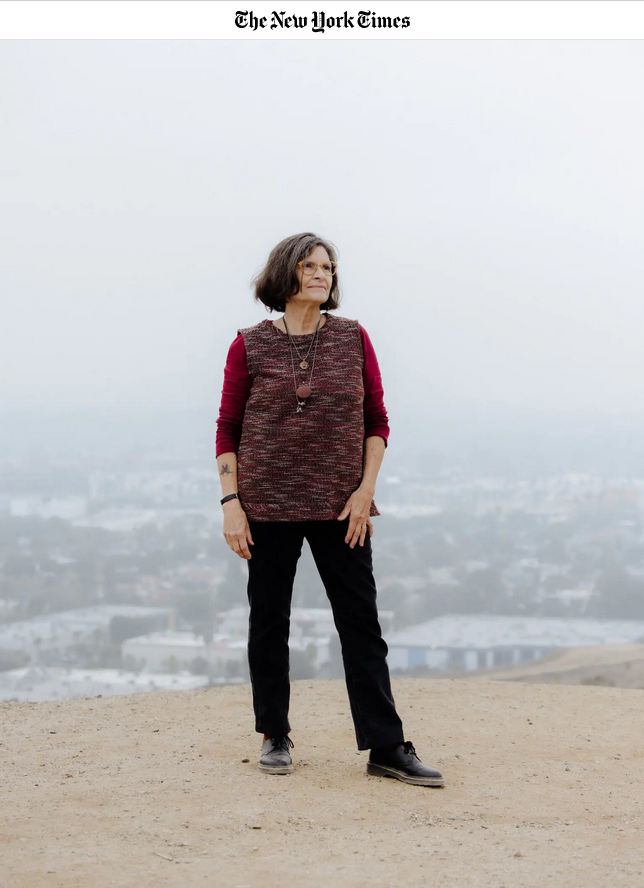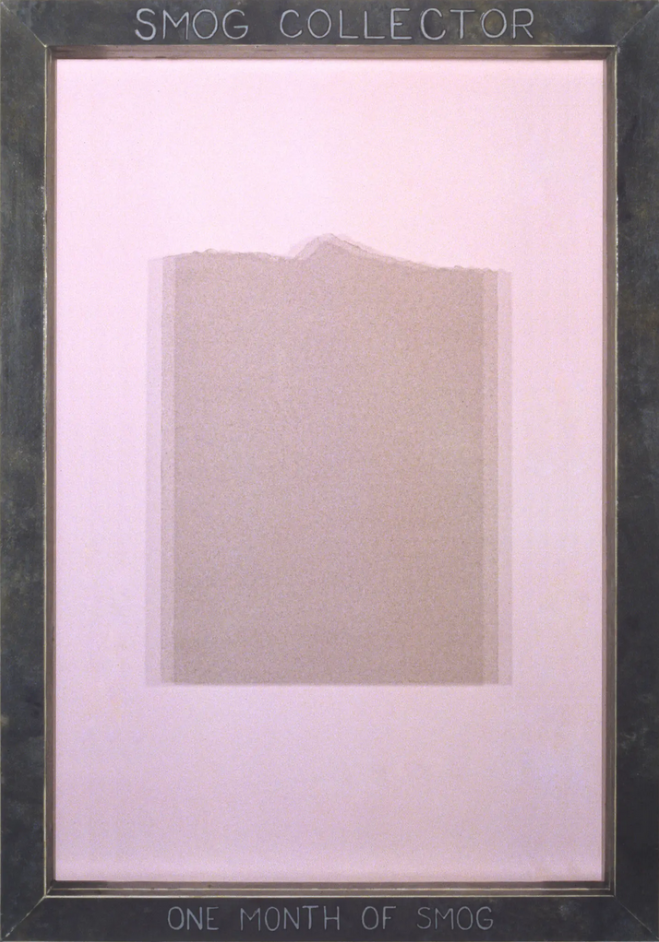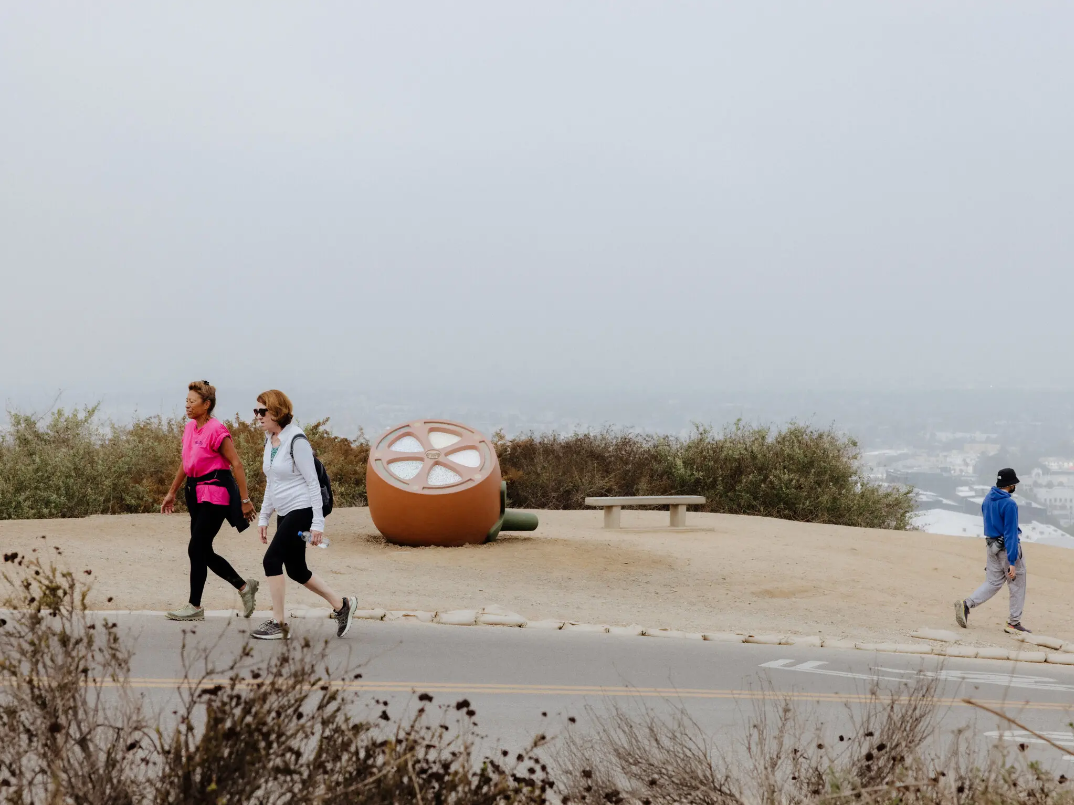
The environmental activist and artist Kim Abeles at the Park to Playa trail in Los Angeles, where her seed sculptures are installed.Credit...Joyce Kim for The New York Times
Kim Abeles Turns the Climate Crisis Into Eco-art
She doesn’t just make art about pollution, she makes art out of it. Now her “Smog Collectors” series is on view at California State University, Fullerton.
By Jori Finkel
Dec. 9, 2021
CULVER CITY — When Kim Abeles had a studio in downtown Los Angeles in the mid 1980s, she was thrilled one day to see a deep bluish wedge appear between two buildings: a sliver of the San Gabriel Mountains, which had for months been obscured by the city’s notoriously thick smog.
Abeles, a conceptual artist by training with roots in nature — she once lived in a grain silo in Ohio — turned her amazement into a project governed by rules of her own making. She set out to photograph that space from her studio fire escape every day until the mountain appeared clearly again. It took a full year and three weeks.
She soon found other ways to approach the wedge. She decided to walk from her studio on Sept. 10, 1987, toward the mountain “as the crow flies,” she said, until she could actually see it. She had to scale barbed wire fences and cross freeways for what proved to be a strenuous 10-hour, 16.5-mile pilgrimage.

“Smog Collector (One Month of Smog)” from 1987, in which the artist gathered smog particulate matter on acrylic. Credit: Kim Abeles
She also experimented that year with a medium that ended up feeding some of her most important work over the last three decades. She cut an image of the mountain wedge into a vinyl sheet covering a plexiglass plate and set it on the fire escape for a month to gather particulate matter. In effect the smog “drew” the image, creating both a record of the pollution — she has called herself “a stenographer of the skyline” — and something meaningful, or even beautiful, from it.
“How do you represent something like the smog, which always looks like it’s in someone else’s neighborhood — how do you show something so elusive and hard to put your finger on?” Abeles, who is 69, said from a clearing near the top of the Baldwin Hills Scenic Overlook in Culver City. With a grand view of Los Angeles stretching out before her, she sat on a bench next to her 10,000 pound sculpture of a manzanita seed, from her series titled
“Citizen Seeds.” The series was made for the
local trail system through a Los Angeles County arts commission and incorporates the handiwork of community members. It was an unnaturally hot day in November, and she pointed to a faint line of pollution in the distance.

“Citizen Seeds (Ode to the Manzanita)” is one of six mixed media sculptures by Kim Abeles that are placed along the Park to Playa Trail.Credit...Joyce Kim for The New York Times
“It’s the same issue with the climate crisis more broadly,” she said. “We need to identify the problem before we can begin to see our collective or individual roles in solving it.”
Her attempts at making the invisible visible, or the abstract tangible, can now be seen in “Kim Abeles: Smog Collectors, 1987-2020” at California State University, Fullerton, the fullest presentation of her smog series to date. The art historian Karen Moss, while pointing out that Abeles has also done major work on AIDS/H.I.V. and domestic violence, said that she has been immersed in environmental issues for 30-plus years — “before other artists jumped in to do what we now call eco-art.”
The Fullerton show includes little-known smog drawings on paper, fabric, wood, glass and recycled plexiglass, starting with that original mountain wedge, as well as her most famous series, commemorative plates of American presidents she made in 1992 by exposing each portrait to the weather for four to 40 days — her way of grading each president’s environmental record.
Presidential commemorative smog plates include “James Carter in 8 Days of Smog” and “Ronald Reagan in 40 Days of Smog.” The plates were placed on a rooftop exposed to the weather for a number of days, reflecting the environmental record of each president; 1992.Credit...Ken Marchionno
The contrast between Jimmy Carter, whose visage appears faint on the porcelain plate (left outside for 8 days), and Ronald Reagan, whose face is dark and smeared with particulate matter (40 days), is especially striking. As she noted, “Carter put solar panels on the White House and Reagan took them down.”
While she’s better known for public art and community workshops than playing to the international art crowd, Abeles was featured in a 2019 show on the politics of environmental disasters at Moscow’s Garage Museum. She set out to make a new set of commemorative plates, this time featuring global leaders from Emmanuel Macron to Vladimir Putin. But a Russian maintenance worker who was spooked by Putin’s dirty plate wiped it clean of all environmental wrongdoing.
Abeles remade it for the Moscow show, and it now appears in her California survey alongside other commemorative plates.
Continue reading on the NYT's website HERE